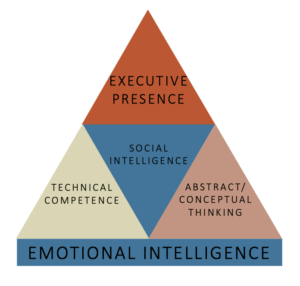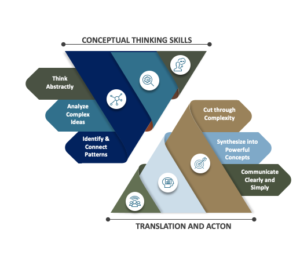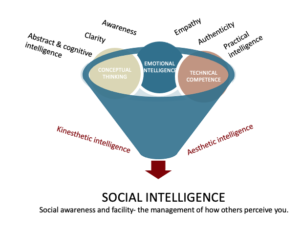 Whether it’s top of mind or not, your executive presence as a leader in higher education will likely influence how successful you’ll be in your leadership career.
Whether it’s top of mind or not, your executive presence as a leader in higher education will likely influence how successful you’ll be in your leadership career.
I specialize in helping higher education leaders develop a strong executive presence. In previous blog posts I have shared three pillars of executive presence and how you can enhance your professional credibility by employing these leadership traits. These pillars are emotional intelligence, technical competence, and abstract/conceptional thinking.
I’ve updated this framework to include a fourth pillar, social intelligence. This pillar is the secret sauce that blends all executive presence competencies into the unique quotient that makes up your individual brand of executive presence.
Before we delve into the definition of social intelligence and how it fits into executive presence, let’s review the executive presence framework in its’ entirety.
First, let’s the answer to the question:
What Is Executive Presence?
At its core, executive presence is about projecting confidence and competence along with a sincere interest in serving others. A working definition includes a mix of mindset, skills, and behaviors that manifests as a multi-dimensional confident, and influential presence. A leader’s executive presence is the energy and essence that they bring to work with them. Ultimately, it is about evoking confidence and competence in a way that makes your peers and collaborators feel heard and empowered to do their best work.
A leader who has a strong executive presence has the confidence to display their own balance of industry and subject matter expertise while leaving the door open for new perspectives. Executive presence is also influenced by a leader’s ability to think critically about complex problems while decisively applying wisdom and insights to make decisions.
In the higher education space, leaders with strong executive presence gain the respect of their peers, colleagues, staff, and students. They are viewed as capable and effective leaders by those around them; this perception allows these leaders to lead effectively and to have flourishing careers.
Executive Presence in Action
Executive presence is gracefully demonstrated by great leaders from all walks of life. Pause and think about the leaders, famed or from your own life, that garner the most respect. How do they conduct themselves? What qualities do they bring as a leader that you most admire?
Some leaders have wit, humor, and charisma. Some can remain calm in extremely challenging circumstances. Others display an awe-inspiring wealth of knowledge on one or many subjects and show compassion in a way that creates positive learning and working environments. Leaders with strong executive presence have all of these qualities, and others that make them so successful. These qualities are also important when interviewing for executive level positions. Access more insight about interview strategy here.
Let’s take a look at the model I’ve developed that incorporates 4 key pillars that comprise executive presence.
1. Emotional Intelligence
In his groundbreaking work on Emotional Intelligence (EI), Daniel Goleman found that EI was a stronger predictor of leadership success than IQ. In the model presented here, emotional intelligence is the foundational pillar for executive presence.
Emotional Intelligence refers to one’s ability to translate emotional cues into strategic thinking and behaviors. Individuals with high EI possess a solid understanding of their own emotional states and the emotional needs of those around them.
Leaders with strong EI are confident in themselves and their abilities. They are assertive communicators, yet they are also thoughtful. This means that high-EI leaders can maintain healthy boundaries while connecting well with others.
Emotional Intelligence and executive presence are highly correlated in the world of higher education. Leaders with high EI are proactive communicators, while leaders with low EI are reactive. This distinction makes a world of difference for the leader and the people they work with.
Leaders who possess Emotional Intelligence are skilled at navigating difficult conversations and are open to hearing diverse perspectives. For instance, a CIO with high EI can balance the competing technology needs of faculty, students, and administrators, even in the face of budget constraints and long development lead times. They can negotiate priorities with empathy and maintain a level head during heated discussions between involved parties.
Individuals with high EI possess a strong sense of self-awareness and can anticipate how others will respond in one-on-one or group meetings. They are skilled at reading people, allowing them to adjust their communication style when appropriate.
Self-awareness and emotional adeptness are needed to achieve leadership success, making it important to develop one’s Emotional Intelligence to enhance executive presence.
2. Technical Competence — Subject Matter Expertise
 The best leaders are masters of their crafts. In higher education, this means that the most successful leaders were first experts in their chosen fields.
The best leaders are masters of their crafts. In higher education, this means that the most successful leaders were first experts in their chosen fields.
Let’s take an example. A university Provost is not only a faculty member but also must be an esteemed contributor to their field, be it biology, botany, or literature. While expertise in their academic discipline is a prerequisite for getting the provost role, it may not directly contribute to their ability to lead successfully. This means that a knowledge of biology, botany, or literature, while needed, is only part of what makes an academic leader successful. An essential success criteria to compliment being an esteemed contributor in their field is bringing broad intellectual capital that harnesses concrete leadership skills necessary for executive presence.
Stepping into the C-Suite, a CIO in a higher education context, is someone who will need to have deep knowledge of technical infrastructure, enterprise systems, and technologies influencing academic and research environments. CIOs must also be involved with the minutiae of an academic institution, like enrollment management, research administration, and grant funding structures. These technical skills, while also essential, are only a part of what makes a great leader.
As a higher education leader climbs in the ranks of an institution, they must continue harnessing their subject matter expertise to gain credibility in their role with their constituents. Technical competence (intellectual capital) includes a portfolio of skills. Essential tools in the intellectual capital tool kit includes the ability to understand and respond to the needs of a diverse student population, an awareness of macroeconomic forces shaping the higher education space, and the leadership capabilities required to negotiate the complex constituent politics inherent in every university and college.
In short, the second pillar of executive presence revolves around being prepared, knowledgeable, and thoroughly experienced in all of the areas that can impact your success as a leader.
3. Conceptual Thinking Skills
 Conceptual thinking refers to a leader’s ability to recognize both short-term and long-term needs and make strategic decisions that satisfy each appropriately.
Conceptual thinking refers to a leader’s ability to recognize both short-term and long-term needs and make strategic decisions that satisfy each appropriately.
The best leaders can consider multiple perspectives that are often derived by accessing deep intellectual capital and broadly apply to a given situation – to make an intentional decision.
Strong conceptual thinking skills allow leaders to:
-
-
- Synthesize complex concepts rapidly
- Identify subtle situational and data patterns
- Think analytically
- Distill complex ideas for their group of collaborators
-
Conceptual thinkers are inherently creative and can fluidly transition between the abstract and the concrete. This allows them to generate innovative ideas and novel solutions with ease.
Some people are born with strong conceptual thinking, while others must strengthen this skill throughout their careers. If you want to improve your executive presence, mastering conceptual thinking is essential, and is a great place to improve.
4. Social Intelligence
 Social intelligence is the final pillar that higher education leaders must possess to have a strong executive presence. Social intelligence is the ability to understand and navigate the complex social environment that is unique to the higher education industry. The social intelligence pillar is where all of the pillars intersect – and inform each leader’s unique brand of executive presence.
Social intelligence is the final pillar that higher education leaders must possess to have a strong executive presence. Social intelligence is the ability to understand and navigate the complex social environment that is unique to the higher education industry. The social intelligence pillar is where all of the pillars intersect – and inform each leader’s unique brand of executive presence.
Situational awareness is a key input into social intelligence. A leader’s ability to understand the needs, interests and political dynamics in any given communication setting is an essential input into garnering social intelligence. Consider a one-one meeting between a provost and CIO to discuss faculty support needs and education technology adoption. Both sides have a stake in the outcome. It is essential to consider how to navigate the political subtext in planning communication strategy- from either perspective. In a one-to-many social interaction, a VP of Student Affairs may have to lead a meeting with staff to roll out new processes to support student success. Careful planning about how this leader “shows up” should include considering emotional intelligence, intellectual capital, and strong strategic thinking skills and presence, are inputs into leading a successful meeting.
Higher education leaders must be able to empathize with and motivate their team members to create an environment of collaboration and trust. They must be able to assess and adjust their responses to different situations to effectively manage a team or organization. Higher education leaders that shine in the social intelligence arena are experts at ‘reading the room.
Finally, higher education leaders must also have the ability to influence, persuade, and unify others around a common goal. Doing this requires the ability to recognize the interests of their stakeholders by reading nonverbal cues, identifying and leveraging social relationships, and by building a culture of trust within their organizations.
Social intelligence is truly at the nexus of the other three pillars of executive presence in that it is informed by a leader’s technical competence, emotional intelligence, and conceptual thinking capabilities.
Build Your Executive Presence by Mastering the 4 Pillars
When you build your technical competence, strengthen your Emotional Intelligence, master conceptual thinking, and bring in your Social Intelligence, your executive presence will soar.
If you or your team need some help with any of the four pillars or would like to improve your executive presence, contact me: [email protected]. I specialize in helping leaders in higher education strengthen their executive presence and I would be delighted to speak with you




